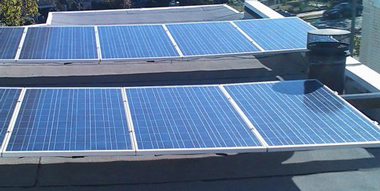Understanding Solar Panel Efficiency Ratings
 A solar panel's efficiency rating measures the rate at which it converts sunlight into electricity.
A solar panel's efficiency rating measures the rate at which it converts sunlight into electricity.
Highly efficient solar panels have the advantage of producing more electricity in a smaller form factor, but they also come at a price premium that reflects their improved efficiency.
This article will break down solar panel efficiency in simple terms, and help you understand whether high-efficiency solar panels are necessary for your project. (Spoiler alert: if space constraints aren't an issue, you might be able to save some money without sacrificing any performance.)
What does Solar Panel Efficiency Actually Measure?
The efficiency of solar panels is based on standard testing conditions (STC), a uniform set of conditions under which all solar panel manufacturers must test their modules. This allows the industry to evaluate the performance of new modules on the market on a level playing field.
Standard test conditions for solar panels specify:
- a temperature of 25°C (77 F)
- solar irradiance of 1000 W/m2
- air mass 1.5 (AM1.5) spectrums
Panels are measured under these conditions to test how much light (solar irradiance) is converted into electricity. After testing, this figure is printed on solar panel spec sheets to reflect the module's efficiency.
Solar Panel Efficiency Benchmarks
With advancements in technology, solar panel efficiency has improved steadily over time. As of 2025, when this article was published, our most efficient solar panels boast an efficiency rating in the 22-25% range. A decade ago, they were in the 13-17% range. We don't have a crystal ball, but we know that panel efficiency will only continue to improve in the future.
Why Does Solar Panel Efficiency Matter?
Highly efficient solar panels are really good at one thing: saving space. If you have a small roof, or your build area is blocked by vents or other obstructions, you may have trouble fitting your solar array into a tight space.
The benefit of efficient solar panels is pretty simple: the more power each panel produces, the fewer you need to meet your energy offset goals. Opting for high-efficiency panels can be the difference between fitting solar on your roof and falling short of your goals.
The counterpoint to this is pretty simple, too. If you have plenty of space to build your system, high-efficiency panels offer no inherent advantages in terms of output. So long as you are meeting your production target, it doesn't really matter whether you are using 350W or 500W panels.
Monocrystalline vs polycrystalline panel efficiency
Standard solar panels are cut from silicon crystals. Monocrystalline panels are named because they're cut from a single crystal, while polycrystalline is a blend of material from different crystals.
Mono panels are more pure, and therefore more efficient than poly panels. Over time, mono has overtaken poly as the most popular pick for home solar systems. Their costs have come down thanks to improved manufacturing processes over time, and they are now more economical on a cost-per-watt basis than poly panels.
Solar panel efficiency: STC or PTC?
The specifications manufacturers advertise are based on standard testing conditions (STC). Manufacturers have to conduct their own testing under these specific conditions, which details the amount of electricity a cell will produce under "standard test conditions."
A module's maximum power (watts), maximum voltage (Vmp), maximum current (Imp), open circuit voltage (Voc), and short circuit current (Isc) are documented under STC and listed on the spec sheet. A module's efficiency is then calculated from STC results, which are used to set the "nameplate rating" of the panel - the expected output of the panel, for example 400W.
But there are also more accurate standards developed through an independent testing laboratory, called PV USA Test Conditions or PTC ratings. Testing a module under PTC has become essential in the US, because California has by far the largest market for solar panels in the US, and they require PTC ratings.
The PTC rating is considered a more accurate assessment of PV module output. In contrast to STC, the PTC rating more closely approximates real solar and climatic conditions. PTC ratings are 1,000 watts/m2, 20 degrees ºC (68ºF), and wind speeds of 1 meter per second at 10 meters above ground level.
PTC ratings were established to evaluate modules outside the lab environment. They document performance in the real world - resulting in lower power ratings than STC values. PTC ratings provide an independent assessment of solar modules and are generally lower than the STC ratings listed on a spec sheet. We look at these PTC values when designing systems to make sure true output does not fall short of production targets, and we recommend solar shoppers do the same.

Questions? Chat With Us.
Get fast answers from real people. We’ll work together to design the perfect DIY solar kit for your project.
Get in touch